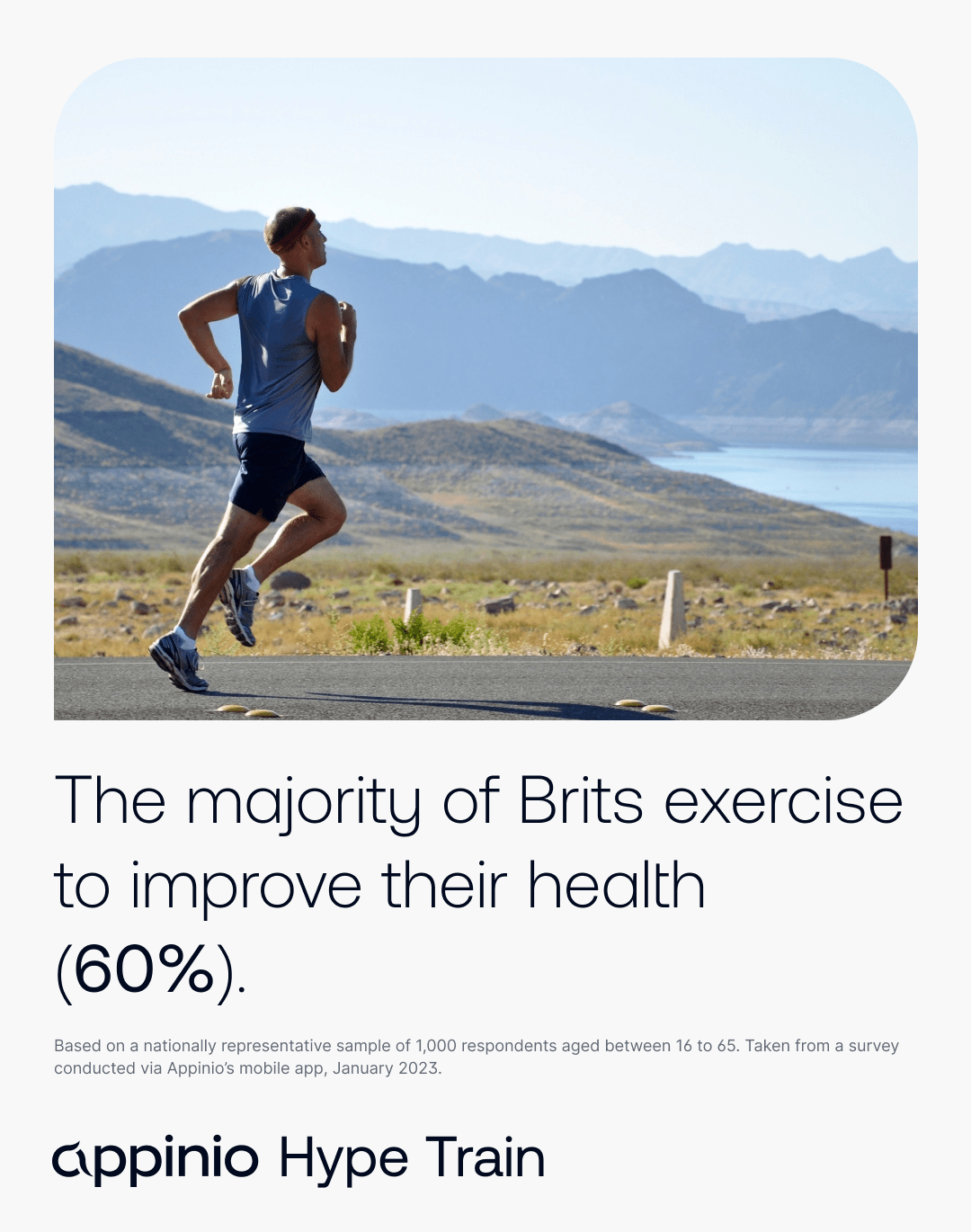Sporty spice or couch potato: Athleisure and sports habits in the UK
Appinio Research · 06.02.2023 · 18min read

Content
The first Appinio Hype Train Report of the year looks at sport, exercise, and sportswear among Brits. With this piece of research, Appinio wanted to understand how attitudes vary across different age groups, what motivates people to get out there and establish healthy habits, but also what kind of equipment they own and what is their opinion of sports clothing.
Exercising regularly has become an essential part of daily life for many people, and it's easy to see why, not only does regular exercise help improve physical health, but it also boosts mental health too.
Sports and how consumers approach sports are also changing rapidly, with new trends such as athleisure becoming increasingly popular, Appinio took a closer look to find out which sports practices Brits engage in and how they use workout gear and sportswear by asking a nationally representative sample of 1.000 Brits between 16 and 65 years old.
Appinio has summarised the entire study results in our Hype Train Report in 10 pages, download your copy of the report for free!
How do Brits work out?
Working out regularly is everyone's dream, no wonder it is always one of the most popular New Years resolutions. You know the gist: new Year, new me, new healthy habits, picking up good habits like working out, eating a lot of veggies, and dropping bad ones like smoking, or locking the sweets cabinet.
But working out is difficult, it requires motivation, effort, commitment, routines, rewiring the brain to pick up the positive habits.
Lacking motivation is actually one of the most common reasons why people do not work out, so it’s no surprise that some people need to device multiple tricks to force themselves to move, i.e. going to bed in workout clothes in order to be ready for the morning run, or watching an episode of their favourite dating show only when they're on the treadmill.
The Appinio Hype Train report actually paints a nice picture for Britain and its sports habits.
When looking more closely, only 15% of Brits claim to never ever work out and they are more likely to fall into the 55-65 years-old age bracket.
So, whether it's a home workout, playing team sports or going to a Pilates studio, 85% of Brits exercise, with 13% exercising every single day of the week, Millennials being the most consistent among age groups (25%).
This is certainly good news as exercise is an essential part of a healthy lifestyle, but this can also be seen as a direct product of the pandemic. In the last years people have been focusing on strengthening their immune system and trying to make themselves more resilient, it is common knowledge that regular physical activity boosts also the immune system, making us more resistant to a plethora of health conditions, not only Covid-19.
In most cases, Brits work out without a proper training plan (42%), and interestingly there's no difference between people that work out at a gym or at home, they have the same chance to work out without a plan whether they're at home or whether they have an entire gym worth of equipment at their disposal.
One third (32%) uses YouTube videos as a guidance, and 27% work out with an app.
Using YouTube videos or apps to exercise can be a convenient and cost-effective way to stay active and reach fitness goals. These resources can offer a wide variety of workout and training options, from beginner to advanced, and can be done in the comfort of one's own home. They also provide the flexibility to choose the workout that best suits people's needs and goals.
However, it's important to note that while being a great resource, they may not be suitable for everyone.
These data, taken all together, paint a very specific picture: the majority of Brits work out with minimal or close to zero guidance.
Using YouTube videos, apps or trying to remember what you did during the PE hour can be a great way to supplement your workout routine and provide variety, but it's not a replacement for guidance and monitoring from sports professionals, so it's important to be cautious.
Check out the full data set free of charge on our Analyser!
Fitness trackers and smartwatches
Wearable devices like fitness trackers and smartwatches have been making their way in everyday life for many.
With their convenience and comprehensive tracking capabilities, fitness trackers and smartwatches have revolutionized the way people approach their health and wellness in general.
But wearables have been taking the spotlight in fitness, making it easier than ever to monitor progress over time and improve performance.
These devices offer a range of features designed to track various aspects of physical activity, such as steps taken, distance covered, calories burned, heart rate, and even sleep patterns.
With their advanced sensors and algorithms, fitness trackers and smartwatches provide users with valuable insights into their daily activity levels and help them set and achieve their fitness goals.
So, even if Brits work out alone and with minimal guidance, a wearable device seem to fill in those gaps for 63% of them, supporting Britons in their health and fitness journey.
![]()
Why do Brits exercise?
People work out for a lot of reasons such as to improve their physical health and fitness, to increase muscle mass and strength, to lose weight and body fat, to improve their overall appearance, and to boost their energy levels and mood. Some people may also work out for specific goals such as to prepare for a sports event, to recover from an injury, or to improve their performance at work or in other activities. Additionally, working out can also be seen as a way to reduce stress, improve sleep and mental health.
So what gets Brits out of their suits or pyjamas and get them to their training session?
Almost two thirds (60%) of Brits who regularly exercise, do so in order to improve their health.

We already mentioned above that this is part of a mindset shift that started already a couple of years ago, going to gym and exercising is not only a way to achieve a specific body ideal but it is first and foremost a way to feel good and stay health.
Furthermore, a 42% work out in order to lose weight, most likely women (52% vs. 33% of men) and 34% work out to build strength and muscles, most likely men (40% vs. 26% of women).
Stereotypes, right?
Where do Brits work out?
There is no such a thing as the best place to work out, it depends on an individual's personal preferences and needs. Some popular options include:
- Gyms, a very common option as they have a wide variety of equipment that people can't really access elsewhere, e.g. weightlifting machines, cardio equipment, and free weights, furthermore, gyms often provide users with personal trainers and sports professionals to give guidance and support.
- Home, a convenient option for people who prefer to work out in the privacy of their own home or have busy schedule. People can exercise and progress at their own pace, without the fear of somebody else picking apart everything they do and without having to spend a lot to get the newest and shiniest workout clothes (even if proper attire is recommended when exercising).
- Outdoor, activities such as running, cycling, hiking or swimming can provide an opportunity to enjoy nature, fresh air and sunshine while working out.
- Studio classes, such as yoga, Pilates, or dance, can provide a fun, social, and high-energy workout.
- Online workout classes and programs, they have become increasingly popular, especially during those lockdown months, allowing individuals to access professional guidance and workout plans from the comfort of their own homes.
But Brits' favourite place to work out is their home. Almost two thirds (58%) work out mostly at home, while 44% work out outdoors as well as another 41% at a gym.
Kudos to all those that work out outdoors as they dare to defy the proverbial British weather!
One in two (51%) of those that usually work out at a gym, studio or club, have a regular membership to access only one gym or studio, while 37% have a membership that grants them access to multiple gyms and studios, another 35% chose a pay-as-you-go subscription (we all know motivation weavers from time to time).
Usually, a Brit going to the gym or studio spends roughly £70 per month, but let's break it down.
Almost one in two (46%) spends less than £50, women being more likely to do so at 53% and older segments being more likely to go to a gym on a budget.
While one third (31%) spend between £50 and £100 and the remaining 23% spend over £100, with 4% spending over £200 a month for their gym needs.
Curious to see which age group spends the most at a gym? Check it out on the Appinio Analyser.
Who do Brits work out with?
Do Brits like to work out alone or do they prefer having company?
Our Appinio Hype Train report was clear, Brits work out on their own (72%), working out with friends happens less often (31%) as well as working out with their partner (24%), even if having a gym-buddy is more popular among the younger demographics.
There are advantages and disadvantage for both cases.
Working out alone can be a great way to focus on one's own goals and progress, without the distractions or pressures of others. People can set their own pace and work at their own level, and they can focus on their own form and technique without feeling self-conscious.
Additionally, working out alone can also be a great way to develop discipline and self-motivation, as the person is the only one responsible for keeping themselves on track. It can also be a great way to improve performance and mental focus, as there are no distractions.
Working out on alone can also be a great way to save time: no need to coordinate with others, work out whenever & wherever, and no need to wait for anyone.
However, working out with a partner or friends can be a great way to stay motivated and accountable to the set fitness goals. Having a workout buddy can provide a sense of accountability, as well as social support and motivation.
Working out with a partner or friends can also make the workout more enjoyable, as buddies can share the experience, push each other to work harder, try new exercises and have fun together.
What is the most popular way of exercising?
According to our survey respondents, running is the most popular type of exercise in the UK with 52% of people engaging regularly in it. As expected, men are more likely to run than women (58% vs. 45%), and younger segments being more likely than older segments to prefer this type of exercise over other, Gen Z seem the age bracket with most runners (63%).
This could be explained by the fact that running doesn't need a lot of equipment, it can be done anywhere, any time and with little costs.
Weight lifting ranks second at 36%, twice as more men than women lift weights (47% vs. 23%) and unsurprisingly, Millennials and Gen Z seem the most likely age groups to engage in this type of training, respectively at 46% and 45%.
Following closely is cycling at 34%, again this seems more popular with men than women (40% vs. 26%), with Millennials being the more likely to engage in this sport.
Athleisurewear: are Brits following the latest trends in sportswear?
Sportswear can be a useful tool to enhance the workout experience, by providing comfort, breathability, flexibility, and motivation. However, it's not a requirement and it's more important to wear clothes that allow fitness enthusiasts to move freely and safely.
The sportswear industry has become huge, the athleisure market is projected to hit US$ 793.46 billion globally by 2028 at 9.9% CAGR.
Let's also consider the immense push that the pandemic has given to this industry, when there was no need for office / business attire as the workforce was working from home, comfy but stylish clothes became the norm and athleisure came to be.
But what is athleisure?
Athleisure is a trend in fashion that combines athletic and leisure wear.
It includes clothing such as workout leggings, sports bras, and athletic shoes that can be worn both during physical activity and in everyday casual settings.
The trend has become increasingly popular in recent years as people seek comfortable and functional clothing that can be worn both in and out of the gym.
One benefit of athleisure is that it allows people to seamlessly transition from a workout to other activities or errands, without needing to change clothes.
It also promotes an active lifestyle and a healthy attitude, as it encourages people to stay active and be comfortable while doing it.
Athleisure can also be seen as a way to express personal style and make a fashion statement. It's a way for people to express their individuality, or even just to recreate that off-duty model look.
But let's deep dive into the data from the Appinio Hype Train Report.
When it comes to sportswear, 37% of all Brits think of Nike, followed by Adidas at 26% and GymShark ranks third but only at 9%.
Almost three in four (73%) of all Brits own sportswear and when considering the purchase of sportswear they consider comfort as the most relevant criteria (65%), however Brits are also price sensitive, 57% consider price when choosing sportswear, lastly 40% takes into account the material and fabrics.
And almost two thirds (59%) wear workout clothes also when they are not working out.
The main reason to do so is comfort (89%), followed by easy to throw on when nothing to wear (46%) and because they are stylish (33%).
Those that don't embrace the athleisure wear trend say that sportswear is not appropriate outside of the gym (49%), they'd feel underdress otherwise (21%) or they don't feel confident enough (13%).
It's difficult to predict the future of any trend, including the athleisure wear trend. However, the athleisure wear trend has been growing in popularity in recent years, and it's likely that it will continue to be a significant part of the fashion and sportswear industry.
Final thoughts on UK sports habits
In this blogpost we have gone through the results collected in our Appinio Hype Train on sports habit in the UK and preferences on workout gears.
We have learned that Brits are quite a sporty bunch, but prefer working out in the comfort of their homes, but they like running outdoors the most.
We have also learned that the three quarters of Brits own sportswear, even those that do not work out and many wear sportswear also outside of a sporty setting because workout gear is comfortable and that many Brits are embracing the athleisure trend, a trend that is set to keep growing in the future.
Interested in running your own study?
Book a demo with our experts, learn how to leverage the Appinio versatile platform and bring your product to the next level.
Get facts and figures 🧠
Want to see more data insights? Our reports are just the right thing for you!


